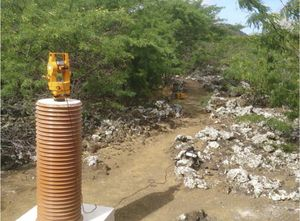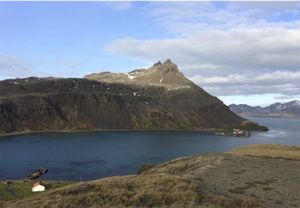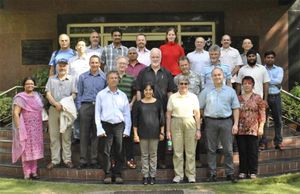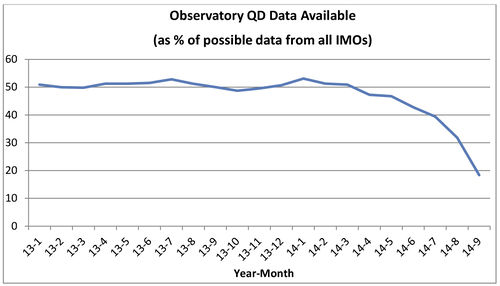OR/15/034 Technical, observatory and field operations
| Alan W P Thomson (editor), Ciarán Beggan, Ellen Clarke, Simon Flower, Brian Hamilton, Gemma Kelly, Sarah Reay, Tony Swan, Alan Thomson, Chris Turbitt (contributors). 2015. Geomagnetism review 2014. British Geological Survey Internal Report, OR/15/034. |

UK and overseas observatories 2014
BGS operates three absolute geomagnetic observatories in the UK and six overseas to supply high quality, real-time measurements for research and services. We also take a leading role in expanding the global observatory network, to improve global modelling and for local applications. The UK observatories achieved 100% continuous data supply in 2014.
Technical developments
The data recorders at all of the observatories were upgraded during 2014 to low-power, solid state PCs to improve battery-backed operation at locations where power cuts are common. These new recording platforms have been specified to support an upgrade to our proprietary recording and communication software that has been in development for the past two years. Our software is now running under the QNX6 real-time operating system, one of the benefits of which has been to allow us to improve internet security in response to increasing cyber threat at remote sites.
Coupled with the roll-out of new recorders and software, we have improved the resolution of the recorded data to 1pT in anticipation of the installation of higher sensitivity magnetometers at the observatories. The first of these instruments, a LEMI-025 fluxgate magnetometer, is now installed on one of the main systems at Eskdalemuir Observatory for long-term performance evaluation.
Magnetic observatories
December 2014 saw the second service visit to the King Edward Point (KEP) Observatory, located in the south Atlantic island of South Georgia. The remoteness of this observatory makes it unique amongst BGS Observatories in its requirements for travel to site, a journey that involves several days at sea. As a consequence of this, observatory visits can only be carried out every two years, creating a special need to ensure that the observatory infrastructure has not degraded in the extreme weather conditions found on the island and that the logging system is robust and operating soundly.
In addition to instrument maintenance and calibrations, special care was given to refurbish the interior of the Absolute Hut to make it weather tight and an environment better suited to manual observations in the depths of winter — aiding the production of better quality results. New members of staff from the British Antarctic Survey base in South Georgia were trained in the making of observations and were given familiarisation briefings on our sensors and logging equipment.
Further visits were made to the remote observatories on Ascension Island, Sable Island, at Port Stanley and in Northern Alaska. With Sable and KEP Observatories now accepted into the INTERMAGNET network, these visits are essential in maintaining the level of data quality and data continuity set by this international data distribution and standards body. The visits also provide opportunity to improve the infrastructure and instrumentation on site.

At Ascension, a new observing pillar was constructed to replace a wooden tripod, making the observing process easier and more accurate, which should lead to an improvement in observation quality. Due to the high gradients in the magnetic field at the site, it was critical that the concrete pillar was precisely positioned at the same location and height as the original tripod.
One of the additions to JCO in Alaska was an electrical power monitor that relays the status of the site electrical supply to an alert system Edinburgh in order that failures are quickly detected and rectified.
A significant improvement to the UK network was the replacement of the on-site generator at Hartland Observatory. Generator-backed electrical supply is one of the measures taken to ensure reliability at observatories that are critical to space-weather or oil industry data supply. The Hartland replacement was carefully co-ordinated to ensure that neither recordings nor communications were disturbed during the work.
At Eskdalemuir, final testing has been completed on a recording system to be installed at a newly established Canadian observatory in support of local oil and gas production. This observatory is expected to be on-stream early in 2015.
The global network and the 2014 IAGA observatories workshop
Some of the performance testing techniques developed by BGS to evaluate new magnetometers were presented at the biennial IAGA Workshop in India. BGS was also represented on the panel during a workshop discussion on the future of magnetic observatory networks and IAGA’s supporting role.
Workshops such as these also provide an opportunity to meet and train observers from international observatories that make use of instrumentation or applications supplied by BGS. One such observatory is the Syrian Observatory, which has operated with a BGS FLARE Plus system since 1998.
UK repeat station network
The 2014 magnetic repeat station programme covered eight measurement locations in east & central Scotland and the east of England. A plan will be implemented in the coming year to upgrade the post-processing software currently used.
The BGS contribution to INTERMAGNET

BGS continues to make a significant contribution to the INTERMAGNET programme (www.intermagnet.org). INTERMAGNET is a consortium of institutes and observatories around the world that make measurements of the Earth’s magnetic field and meet agreed quality standards. BGS leads the work on development of and compliance with INTERMAGNET standards and INTERMAGNET’s IT infrastructure. In October 2014 the regular INTERMAGNET meeting was held in Hyderabad, India, after the IAGA magnetic observatories workshop. Both meetings were hosted by the National Geophysical Research Institute.
All change at the top
Three out of the four members of the INTERMAGNET Executive Council, including the chairperson, moved on in 2014, including David Kerridge of BGS who had served since 1992. Alan Thomson from BGS has now been appointed to INTERMAGNET’s Executive Council and is the new INTERMAGNET chairperson. We also have two representatives on the operations committee: Chris Turbitt and Simon Flower.
The World Data System
INTERMAGNET has been awarded ‘network’ membership of the World Data System (https://www.icsu-wds.org/). The World Data System is an interdisciplinary body of the International Council for Science and exists to enable universal and equitable access to quality-assured scientific data and information and to ensure long term data stewardship.
First evaluation of QD data
INTERMAGNET has been collecting quasi-definitive (QD) data since 2012. One of the features of this data product is that it is not possible to evaluate the quality of the data until the corresponding definitive data has been created. The INTERMAGNET meeting in Hyderabad provided the first opportunity to evaluate the quality of QD data that has been provided to INTERMAGNET.
40 of the 140 INTERMAGNET observatories provided QD data in 2012. Out of these 38 observatories produced data that is compliant with the QD standard (which states that quasi-definitive data should be within 5nT of the definitive data).
These results, for the first year of a new data product, show that the production of quasi-definitive data is realistic proposition. There is room for improvement in the number of observatories who contribute this data and INTERMAGNET has been working to convince the operators of the benefits of producing this data product. The Figure below shows statistics on the amount of QD data received in 2013/14 (the drop off at the end is due to data not yet received at the time of preparing the Figure).
One second data product
INTERMAGNET is about to start producing a major new data product: one-second data. Although INTERMAGNET currently collects one-second data, this is provided by observatories on a ‘best endeavours’ basis and does not conform to any particular standard.
INTERMAGNET has agreed a challenging but realistic standard for one-second data that observatories will, in most cases, need to work towards. A new data format has been agreed for this data.
BGS staff have led the work to create these new standards. Work is ongoing to create tools for data quality control and, ultimately, for users to be able to work with the data. It is hoped to make a first call for one-second definitive data in 2015 (for data recorded in 2014).
